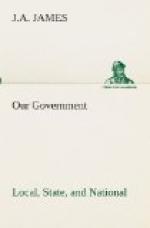8. The Fifteenth Annual Report of the commission (pp. 443-485) contains an account of the appointments and removals by the various Presidents from 1789 to 1883. Also an account of the growth of civil service reform in the States and cities of the United States, pp. 489-502.
9. May a man be fitted for political preferment and not be competent to pass an adequate examination?
10. For other articles on civil service reform, see (a) The Civil Service and the Merit System, Forum, 27: 705-712. (b) Some Popular Objections to Civil Service Reform, Atl. Mo., 65: 433-444; 671-678. (c) Roosevelt, An Object Lesson in Civil Service Reform, Atl. Mo., 67: 252-257. (d) George William Curtis and Civil Service Reform, Atl. Mo., 75: 15-24. (e) Rice, Improvement of the Civil Service, N. Am. Rev., 161: 601-611. (f) Roosevelt, Present Status of Civil Service Reform, Atl. Mo., 75: 239-246. (g) Roosevelt, Six Years of Civil Service Reform, Scribner’s Mag., 18: 238-247. (h) The Purpose of Civil Service Reform, Forum, 30: 608-619.
11. What was the Tenure of Office Act of 1867? Why did it become of great importance? Is it still in force? Wilson, Division and Reunion, 267, 270-271, 297; Harrison, This Country of Ours, 101-103.
12. What were the chief points discussed in the President’s last annual message?
CHAPTER XV.
THE CABINET.
Formation of Departments.—The Constitution nowhere mentions the President’s Cabinet. It was taken for granted, however, that departments similar to those found in the Cabinet would be formed. The Constitution declares that the President “may require the opinions in writing of the heads of the executive departments,” and again, that “Congress may vest the appointment of certain inferior officers in the heads of these departments.”
In 1789 the first Congress created the Departments of State, War, and Treasury, also the office of Attorney-General. President Washington’s Cabinet consisted of the officials whom he appointed to fill these four positions. The Navy Department was added in 1798. While a Post-Office Department was established in 1794, the Postmaster-General was not made a member of the Cabinet until 1829. In 1849, the Interior Department was created by grouping under it certain duties which had belonged to other departments. The Department of Agriculture was made a Cabinet position in 1889. In 1903 the Department of Commerce and Labor was authorized by an Act of Congress, and in 1913 the Department of Labor was created. Members of the Cabinet receive an annual salary of $12,000.
The President and His Cabinet.—One of the first official acts of a President is to send to the Senate, for its approval, the names of the men whom he desires shall constitute his Cabinet. This is now a mere formality. The President is himself the one most interested in the success of his administration and is of right given complete freedom in selecting his immediate advisers. While the views of the members of the Cabinet usually have weight with the President, he is not obliged to take their advice. Indeed, in some instances the President has carried out a line of action which was against the wishes of the secretary of the department affected.




